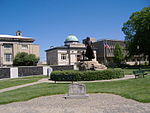Big Four Bridge

The Big Four Bridge is a six-span former railroad truss bridge that crosses the Ohio River, connecting Louisville, Kentucky, and Jeffersonville, Indiana. It was completed in 1895, updated in 1929, taken out of rail service in 1968, and converted to bicycle and pedestrian use in 2014. The largest single span is 547 feet (167 m), with the entire bridge spanning 2,525 feet (770 m). It took its name from the defunct Cleveland, Cincinnati, Chicago and St. Louis Railway, which was nicknamed the "Big Four Railroad". Access to the Big Four Bridge is limited to pedestrian and bicycle use. A pedestrian ramp on the Kentucky side was opened on February 7, 2013. The original approaches that carried rail traffic onto the main spans were first removed in 1974–1975, earning the Big Four Bridge the nickname "Bridge That Goes Nowhere". The George Rogers Clark Memorial Bridge downstream, which carries U.S. 31 across the river, was previously the only bridge allowing bicyclists and pedestrians to travel between Louisville and the neighboring Indiana cities of New Albany, Clarksville, and Jeffersonville. In February 2011, Kentucky and Indiana announced that the two states, along with the City of Jeffersonville, would allocate $22 million in funding to complete the Big Four Bridge project, creating a pedestrian and bicycle path to link Louisville and Jeffersonville. Indiana would spend up to $8 million and the City of Jeffersonville would provide $2 million in matching dollars to pay for construction of a ramp to the Big Four Bridge. Kentucky pledged $12 million to replace the deck on the bridge and connect it to the spiral ramp that was completed in Waterfront Park. On February 7, 2013, the Louisville ramp was opened for pedestrian and bicycle traffic. Initially planned for August 2013, the Jeffersonville ramp opened on May 20, 2014.
Excerpt from the Wikipedia article Big Four Bridge (License: CC BY-SA 3.0, Authors, Images).Big Four Bridge
Big Four Bridge, Louisville
Geographical coordinates (GPS) Address Nearby Places Show on map
Geographical coordinates (GPS)
| Latitude | Longitude |
|---|---|
| N 38.265555555556 ° | E -85.738888888889 ° |
Address
Big Four Bridge
Big Four Bridge
40202 Louisville
Kentucky, United States
Open on Google Maps











